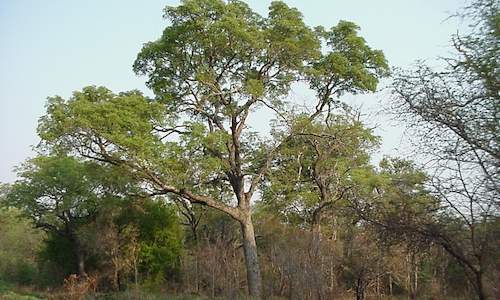
Inside a rock-hard nut lie the precious seeds of the marula tree, a treasure for persistent squirrels and an amazing storehouse of energy that drives the growth of a resilient seedling. New research by Susan Botha has revealed that a freshly germinated marula seedling can survive for over a year without water if it is just kept moist for its first month above the ground.
In an experiment to determine what makes a savanna tree seedling survive from the rainy season in which it germinates until the rains start again the following year, Susan has found that marula trees can survive drought more readily than some other species. Comparing different tree species showed that when seedlings were grown for the same number of days, the marula produced by far the most roots.
Marula seedlings, compared to seedlings of silver cluster leaf, apple-leaf or knobthorn, then went on to survive for almost twice as long without watering as the other species, surviving on average for nearly 100 more days without water.
Susan germinated and grew the four species in a greenhouse, and discovered that no matter what a seedling looked like - whether they produced lots of small leaves or a few large leaves, or had well-developed or poorly-developed root systems - the seedling died once soil moisture dropped below a certain point.
This suggests that bigger seedlings cannot rely on water stored in their roots to help them survive dry periods. Rather, all the seedlings in the study produced long taproots as fast as they could, reaching towards more permanent water supplies below the ground. When this water diminishes, the seedling will die no matter how big it was able to grow beforehand.
Of all the species Susan germinated and grew in the greenhouse, the silver cluster leaf was the hardest to germinate, needing to be kept moist for almost two months before the first hint of green emerged from the soil. This ties in with field observations in the Pretoriuskop area, which saw a massive germination of this species only after long periods of rainfall.
Susan's greenhouse experiment growing seedlings under controlled conditions follows on from her other work carried out in the field in Kruger, where she germinated seeds from 12 different tree species in plots inside the Pretoriuskop and Lower Sabie camps.
By putting plastic roofs over seedlings to prevent rain from entering, she found that her knobthorn and apple-leaf seedlings could survive an 11-month dry season after germinating and getting established in a below average rainfall year.
Only five percent of the knobthorn seedlings died during this long continuous dry spell, with 16 percent of the apple-leaf plants dying. She found that most seedling deaths occurred after seedlings had just germinated, which suggests that they suffer more from dry spells in the middle of the rainy season than the long dry stretch over winter until the following rainy season.
This seems to explain why seeds of all the species germinated at Susan's field sites in the middle of the rainy season. Analysis of past rainfall records showed that rainfall is more regular in the middle of the season, rather than at the beginning or the end.
Theoretically, a seedling germinating at the beginning of a rainy season would have more time to grow and put down energy stores to survive over winter than a seedling that only germinated in the middle of the rainy season, provided mid-season droughts were not a factor.

Other aspects of what turns a seed into a successful tree were covered. One theory suggests that every year trees shed seeds and these seeds can lie in the ground for years, making a seed bank, before conditions are suitable for them to germinate. Susan tested this theory by digging up blocks of soil and sieving them to look for seeds.
Her search was fruitless, and in 100 samples collected near Satara and Pretoriuskop, no seeds were found. The seed bank theory also received another blow from the fact that over two growing seasons, intensive searching for any germinating tree seeds near Satara, Pretoriuskop and Lower Sabie only turned up a few marula seedlings, and the mass germination of some silver cluster leaf seeds near Pretoriuskop.
When Susan collected seeds from the 12 species and planted them, the seeds readily germinated after heavy natural rainfall, suggesting that if there had been seeds in the soil in the veld, they would have germinated.
Susan's work is offering new insight into how the seeds that a savanna tree scatters may eventually turn into another mature specimen, and how those seeds overcome the challenges of erratic rainfall, both within a growing season and from one season to another.
The big marula nuts with their relatively large seeds have shown their strengths in the field and the greenhouse, germinating easily, producing extensive root networks, and surviving for a year on just one month's growth.
It is little wonder that this tree is one of the most widespread species in the Kruger National Park, occurring naturally from north to south, east to west. This leaves the puzzle of why, if marula seedlings appear to be so tough, many people say that new seedlings and saplings of marula are hard to find in the veld.
By Melissa Wray

 The history of the marula tree goes back thousands of years. Archaeological evidence shows the marula tree was a source of nutrition as long...
The history of the marula tree goes back thousands of years. Archaeological evidence shows the marula tree was a source of nutrition as long...